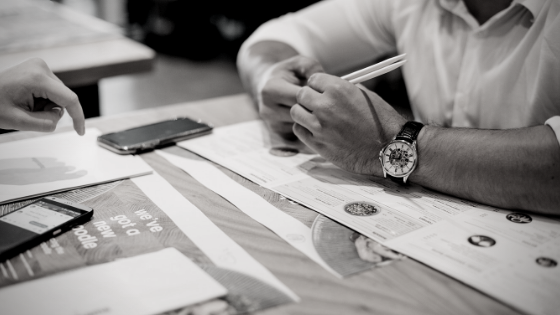It’s dark, and wet. I’m carrying more things than my arms are comfortable carrying, grasping my house key between cold, numb fingers. Hunched against the cold, I open the front door prepared to step into a completely dark house… only to find that the entryway light is already on. Ah, lovely.
Then I remember that just a few days earlier I had created an IFTTT applet for this exact purpose. Don’t know what that means? Well, the short version is that through the magic of technology, my household lighting system knew I was coming home after dark and switched itself on as I approached the house.

It’s pronounced like “lift”
“IFTTT” stands for “If This, Then That”. The IFTTT app and website allow you to connect different apps and online services to take certain actions whenever a particular trigger occurs. In this case:
| Trigger | Action |
| IF my mobile phone comes within 50 meters of the house after sunset, | THEN turn on the entryway light. |
But you can use it for other things too. For example:
| Trigger | Action |
| IF I’m tagged in a photo on facebook, | THEN save a copy of that photo to my dropbox folder. |
| IF it’s going to rain tomorrow, | THEN send me an email. |
| IF I make a phone call, | THEN log that call on a spreadsheet. |
IFTTT is pretty cool. But why am I talking about it in an article about working from home?
Because your brain is pretty much one big IFTTT machine.
You are a creature of habit
Like it or not, you are a creature of habit.
Human brains rely on habit, and that’s great! Habit helps you get things done. Habit is what helps you get up, eat breakfast, hop in the shower, brush your teeth, and so on, every single day without really having to think about it.
If you had to actively decide every little thing you do, you’d be out of mental energy well before lunchtime.
Lucky for you, your brain is really great at going on autopilot, so that you can save your focus and energy for the things that really matter.
Why you need a pre-work ritual
If you travel to a particular location for work every day, your brain has formed an IFTTT habit without you even realising it. Here’s the habit:
| Trigger | Action |
| IF I have just arrived at my workplace, | THEN I will get started on work. |
When you work from home, you don’t have that trigger. So you need to give your brain the gift of an IFTTT. You need a pre-work ritual.
The ritual doesn’t need to be complicated. In fact, the ideal pre-work ritual is:
- Simple: Something that’s easy to do
- 10–30 minutes: Something that doesn’t take too much time out of your day
- Enjoyable: Something you actually want to do
These are important, because otherwise you’re likely to procrastinate on your pre-work ritual.
Here are some examples:
| Trigger | Action |
| IF I sit and read while drinking a cup of peppermint tea, | THEN I will get started on work. |
| IF I go for a 20-minute walk with the dog, | THEN I will get started on work. |
| IF I do my morning yoga, | THEN I will get started on work. |
| IF I do 10 minutes of mindfulness meditation, | THEN I will get started on work. |
Staying in “work mode” throughout the day
So if a pre-work ritual can help you to start the day in “work mode”, how do you stay in work mode throughout the day?
For this, you need triggers that last all day.
One especially powerful trigger that lasts a long time is the location we are in. For example:
| Trigger | Action |
| IF I am at my workplace, | THEN it is time to work. |
| IF I am at the gym | THEN it is time to work out. |
| IF I am in the living room | THEN it is time to relax. |
| IF I am in the kitchen | THEN it is time to eat. |
Staying focused on work at home can be especially tricky because your brain doesn’t associate home with work. Even if you usually work from home you also do many other activities there, and this confuses things.
So you need to help your brain out. You need to give it a work-trigger that lasts all day.
Tell your brain that you’re in a work environment
The good news is, you don’t actually need to change buildings to create a sense of being somewhere “different” to your relaxation-triggering living room.
If you’ve ever walked into a room that’s been decorated for a party, or just been painted, and thought “Wow, this feels like a completely different room,” then you know what I’m talking about.
Here are some options for work-triggers that set work time apart from relaxation time:
- Set aside a place in your home for work. If you have a home office, great. If not, then maybe there’s a small desk or table you can claim as a work-only space. Maybe there’s a particular chair in your living room that you never use when you’re relaxing (because hey, it faces away from the TV) that you can use as your work-chair.
- Change how things look on your computer when you’re in work mode. Create a separate profile on your computer to use when you’re working, with a different wallpaper image. Set a background image for your work email inbox that’s different to your personal email inbox. (Bonus points if you use colours that you associate with your job, such as your branding colours.)
- Have work-specific music. Have a playlist of work music, which you don’t listen to at any other time. (Just make sure that it’s music that actually allows you to concentrate.)
- Wear work-appropriate clothing. This one isn’t my favourite, because I really like being comfortable. But a lot of people swear by putting on business attire and shoes (apparently the shoes are very important) to get themselves into the right frame of mind for work. This trick will work best you if you come from a corporate background and have spent years wearing business attire at work.
Research shows that tiny environmental cues like these are often enough to make your brain act like it’s in a “different place”:
| Trigger | Action |
| IF I am at my desk | THEN it is time to work. |
| IF I am looking at green wallpaper | THEN it is time to work. |
| IF I am listening to classical music | THEN it is time to work. |
| IF I am wearing business attire | THEN it is time to work. |
Pick the right time to get started
Get started with your new triggers at the right time. Pick a week when you’re not feeling overwhelmed, sleepy, or otherwise low on energy.
For those first few days, you’ll need a helping of willpower to get started and to keep focusing on your work.
But once the new IFTTT habits take hold, that’s when the magic happens. That’s when it becomes easy to focus on your work even when you’re feeling overwhelmed, sleepy, or low on energy.
No willpower required.





















